
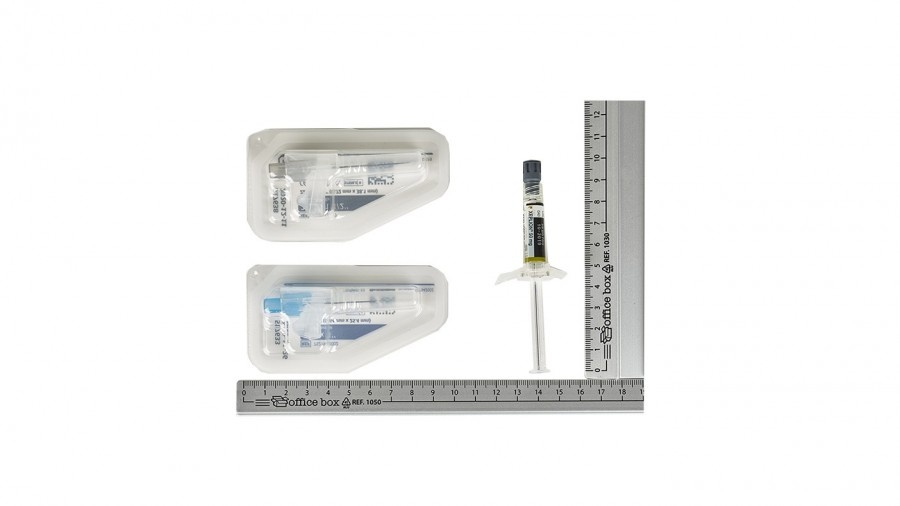
ПАЛЬМЕУКС 50 мг СУСПЕНЗІЯ ДЛЯ ІН'ЄКЦІЙ ПРОЛОНГОВАНОЇ ДІЇ У ПЕРЕДНАПОВНЕНИХ ШПРИЦАХ


Інструкція із застосування ПАЛЬМЕУКС 50 мг СУСПЕНЗІЯ ДЛЯ ІН'ЄКЦІЙ ПРОЛОНГОВАНОЇ ДІЇ У ПЕРЕДНАПОВНЕНИХ ШПРИЦАХ
Введення
Опис: інформація для користувача
Палмей 25мг суспензія для ін'єкційз тривалою дією в попередньо заповненому шприці EFG
Палмей 50мг суспензія для ін'єкцій з тривалою дією в попередньо заповненому шприці EFG
Палмей 75мг суспензія для ін'єкцій з тривалою дією в попередньо заповненому шприці EFG
Палмей 100мг суспензія для ін'єкцій з тривалою дією в попередньо заповненому шприці EFG
Палмей 150мг суспензія для ін'єкцій з тривалою дією в попередньо заповненому шприці EFG
Паліперидон
Прочитайте уважно весь опис перед тим, як почати використовувати цей лікарський засіб, оскільки він містить важливу інформацію для вас.
- Збережіть цей опис, оскільки вам може знадобитися знову прочитати його.
- Якщо у вас є якісь питання, проконсультуйтеся з вашим лікарем, фармацевтом або медсестрою.
- Якщо ви відчуваєте побічні ефекти, проконсультуйтеся з вашим лікарем, фармацевтом або медсестрою, навіть якщо це побічні ефекти, які не вказані в цьому описі. Див. розділ 4.
Зміст опису
- Що таке Палмей і для чого він використовується
- Що вам потрібно знати перед тим, як почати використовувати Палмей
- Як використовувати Палмей
- Можливі побічні ефекти
- Зберігання Палмею
- Зміст упаковки та додаткова інформація
1. Що таке Палмей і для чого він використовується
Цей лікарський засіб містить активну речовину паліперидон, який належить до класу антипсихотичних лікарських засобів і використовується як підтримуюче лікування симптомів шизофренії у дорослих пацієнтів, які стабілізувалися під впливом паліперидону або рисперидону.
Якщо ви раніше реагували на паліперидон або рисперидон і маєте легкі або помірні симптоми, ваш лікар може призначити лікування Палмеєм без попередньої стабілізації під впливом паліперидону або рисперидону.
Шизофренія - це розлад з симптомами «позитивними» і «негативними». Позитивний означає надмірність симптомів, які зазвичай не присутні. Наприклад, людина з шизофренією може чути голоси або бачити речі, які не існують (галюцинації), мати помилкові переконання (марення) або мати надмірну підозрілість до інших. Негативний стосується відсутності поведінки або почуттів, які зазвичай присутні. Наприклад, людина з шизофренією може ізолюватися від інших і не реагувати на жодні емоційні стимули або можуть мати проблеми з чіткою і логічною мовою. Люди, які страждають на цей розлад, також можуть відчувати депресію, тривогу, провину або напруженість.
Цей лікарський засіб може допомогти полегшити симптоми вашої хвороби і запобігти їх поверненню.
2. Що вам потрібно знати перед тим, як почати використовувати Палмей
Не використовуйте Палмей:
- якщо ви алергічні на паліперидон або на будь-який інший компонент цього лікарського засобу (перелічені в розділі 6).
- якщо ви алергічні на будь-який інший антипсихотичний лікарський засіб, включно з рисперидоном.
Попередження та обережність
Проконсультуйтеся з вашим лікарем, фармацевтом або медсестрою перед тим, як почати використовувати Палмей.
Цей лікарський засіб не був вивчений у пацієнтів похилого віку з деменцією. Однак пацієнти похилого віку з деменцією, які лікуються іншими подібними лікарськими засобами, можуть мати підвищений ризик інсульту або смерті (див. розділ 4, можливі побічні ефекти).
Усі лікарські засоби мають побічні ефекти, і деякі з них можуть погіршити симптоми інших захворювань. Тому важливо обговорити з вашим лікарем будь-які з наступних захворювань, які можуть погіршитися під час лікування цим лікарським засобом:
- якщо у вас є хвороба Паркінсона
- якщо ви раніше були діагностовані з захворюванням, симптомами якого є підвищена температура і м'язова ригідність (також відоме як синдром нейролептичної мальгнізації)
- якщо ви раніше мали аномальні рухи мови або обличчя (тардива дискінезія)
- якщо у вас були низькі рівні лейкоцитів у крові (що може бути викликано іншими лікарськими засобами)
- якщо ви страждаєте на цукровий діабет або маєте схильність до нього
- якщо у вас був рак молочної залози або пухлина гіпофізу мозку
- якщо у вас є захворювання серця або ви приймаєте лікування серцевих захворювань, яке може зробити вас більш схильним до зниження артеріального тиску
- якщо у вас є низький артеріальний тиск, коли ви встаєте або швидко змінюєте положення
- якщо у вас є епілепсія
- якщо у вас є захворювання нирок
- якщо у вас є захворювання печінки
- якщо у вас є тривала або болюча ерекція
- якщо у вас є труднощі з регулюванням температури тіла або ви перебуваєте в умовах підвищеної температури
- якщо у вас є аномально високий рівень гормону пролактину в крові або якщо у вас є пухлина, яка може залежати від пролактину
- якщо ви або хтось з вашої сім'ї має історію тромбозу, оскільки антипсихотичні лікарські засоби можуть бути пов'язані з утворенням тромбів.
Якщо у вас є будь-яке з цих захворювань, будь ласка, проконсультуйтеся з вашим лікарем, оскільки може знадобитися корекція вашої дози або спостереження за вами протягом певного часу.
Через те, що дуже рідко спостерігалося у пацієнтів, які приймають цей лікарський засіб, небезпечно низький рівень певного типу лейкоцитів, необхідних для боротьби з інфекціями в крові, ваш лікар може перевіряти рівень лейкоцитів у вашій крові.
Навіть якщо ви раніше переносили пероральний паліперидон або рисперидон, рідко трапляються алергічні реакції після ін'єкцій Палмею. Проконсультуйтеся з вашим лікарем негайно, якщо ви відчуваєте висип, набряк горла, свербіж або проблеми з диханням, оскільки ці можуть бути ознаками важкої алергічної реакції.
Цей лікарський засіб може спричинити збільшення ваги. Значне збільшення ваги може негативно вплинути на ваше здоров'я. Ваш лікар буде регулярно відстежувати вашу вагу.
У пацієнтів, які приймають цей лікарський засіб, спостерігалося цукровий діабет або погіршення діабету, який вже існував, ваш лікар повинен перевіряти ознаки підвищення рівня цукру в крові. У пацієнтів з діабетом, який уже існував, потрібно регулярно відстежувати рівень цукру в крові.
Через те, що цей лікарський засіб може зменшити блювотний рефлекс, існує можливість того, що він може маскувати нормальну реакцію організму на прийняття токсичних речовин або інших захворювань.
Під час операції на очах з катарактою зіниці (коловий отвір в центрі очей) можуть не розширюватися належним чином. Крім того, райдужна оболонка (кольорова частина очей) може ставати флячкою під час операції, що може спричинити пошкодження очей. Якщо ви плануєте операцію на очах, повідомте вашого офтальмолога про те, що ви приймаєте цей лікарський засіб.
Діти та підлітки
Не використовуйте цей лікарський засіб у дітей молодших 18 років.
Інші лікарські засоби та Палмей
Повідомте вашого лікаря, якщо ви приймаєте, нещодавно приймали або можете приймати інші лікарські засоби.
Прийом цього лікарського засобу разом з карбамазепіном (антиепілептичним та стабілізуючим настрій лікарським засобом) може потребувати корекції вашої дози цього лікарського засобу.
Через те, що цей лікарський засіб діє в основному на мозок, взаємодія з іншими лікарськими засобами, які також діють на мозок, може спричинити посилення побічних ефектів, таких як сонливість або інші ефекти на мозок, наприклад, інші психіатричні лікарські засоби, опіоїди, антигістамінні лікарські засоби та снодійні лікарські засоби.
Через те, що цей лікарський засіб може знижувати артеріальний тиск, вам потрібно бути обережним, якщо ви приймаєте цей лікарський засіб разом з іншими лікарськими засобами, які також знижують артеріальний тиск.
Цей лікарський засіб може знижувати ефект лікарських засобів для лікування хвороби Паркінсона та синдрому неспокійних ніг (наприклад, леводопи).
Цей лікарський засіб може спричинити аномалію на електрокардіограмі (ЕКГ), яка вказує на те, що потрібно тривале время для проходження електричного імпульсу через певну частину серця (відоме як «пролонгування інтервалу QT»). Інші лікарські засоби, які мають цей ефект, включають деякі лікарські засоби, які використовуються для лікування серцевого ритму або для лікування інфекцій, а також інші антипсихотичні лікарські засоби.
Якщо ви схильні до розвитку судом, цей лікарський засіб може збільшити ваші шанси на розвиток судом. Інші лікарські засоби, які мають цей ефект, включають деякі лікарські засоби, які використовуються для лікування депресії або для лікування інфекцій, а також інші антипсихотичні лікарські засоби.
Палмей повинен використовуватися з обережністю з лікарськими засобами, які збільшують активність центральної нервової системи (психостимулятори, такі як метилфенідат).
Палмей та алкоголь
Алкоголь слід уникати.
Вагітність та лактація
Якщо ви вагітні або перебуваєте в період лактації, вважаєте, що можете бути вагітною або плануєте вагітність, проконсультуйтеся з вашим лікарем або фармацевтом перед тим, як використовувати цей лікарський засіб. Не слід використовувати цей лікарський засіб під час вагітності, якщо тільки ваш лікар не порадив вам цього. Можуть виникнути наступні симптоми у новонароджених дітей матерів, які приймали паліперидон у третьому триместрі вагітності (останні три місяці вагітності): тремор, ригідність та/або м'язова слабкість, сонливість, агітація, проблеми з диханням та труднощі з харчуванням. Якщо ваша дитина розвиває будь-які з цих симптомів, ви повинні проконсультуватися з вашим лікарем.
Цей лікарський засіб може передаватися від матері до дитини через грудне молоко та може нашкодити дитині. Тому не слід годувати грудьми під час прийому цього лікарського засобу.
Водіння транспортних засобів та використання машин
Під час лікування цим лікарським засобом можуть виникати головокружіння, надмірна втома та проблеми з зором (див. розділ 4). Це повинно бути враховано при вимозі максимальної уваги, наприклад, при водінні транспортних засобів або використанні машин.
Палмей містить натрій
Цей лікарський засіб містить менше 1 ммоль натрію (23 мг) на дозу; тобто, він практично «не містить натрію».
.
3. Як використовувати Палмей.
Ваш лікар або інший медичний працівник введе цей лікарський засіб. Ваш лікар призначить час наступної ін'єкції. важливо не пропускати жодної з призначених ін'єкцій. Якщо ви не можете відвідати свого лікаря, повідомте його негайно, щоб призначити інший термін якнайшвидше.
Ви отримаєте першу ін'єкцію (150 мг) та другу ін'єкцію (100 мг) цього лікарського засобу в верхню частину плеча з інтервалом приблизно один тиждень. Після цього ви отримаєте ін'єкцію (від 25 мг до 150 мг) в верхню частину плеча або в сідниці один раз на місяць.
Якщо ваш лікар заміняє рисперидон ін'єкцій з тривалою дією на цей лікарський засіб, ви отримаєте першу ін'єкцію цього лікарського засобу (від 25 мг до 150 мг) в верхню частину плеча або в сідниці під час наступної призначеної ін'єкції. Після цього ви отримаєте ін'єкцію (від 25 мг до 150 мг) в верхню частину плеча або в сідниці один раз на місяць.
Залежно від ваших симптомів, лікар може збільшити або зменшити кількість лікарського засобу, який ви отримуєте на рівні дози під час місячного призначення ін'єкції.
Пацієнти з захворюваннями нирок
Ваш лікар може коригувати дозу цього лікарського засобу відповідно до вашої ниркової функції. Якщо у вас є легкі захворювання нирок, ваш лікар може призначити меншу дозу. Не слід використовувати цей лікарський засіб, якщо у вас є захворювання нирок середньої або важкої ступеня.
Пацієнти похилого віку
Ваш лікар може зменшити дозу цього лікарського засобу, якщо ваша ниркова функція знижена.
Якщо ви отримали більше Палмею, ніж потрібно
Ви отримаєте цей лікарський засіб під медичним наглядом; тому малоймовірно, що ви отримаєте надмірну дозу.
Пацієнти, які отримали надмірну дозу паліперидону, можуть відчувати такі симптоми: сонливість або седація, швидка серцева діяльність, низький артеріальний тиск, аномалії на електрокардіограмі (запис електричної діяльності серця), або повільні або аномальні рухи обличчя, тіла, рук або ніг.
У разі передозування або випадкового прийому лікарського засобу проконсультуйтеся з вашим лікарем, фармацевтом або медсестрою негайно або зверніться до служби токсикологічної інформації, телефон 91 562 04 20, вказавши лікарський засіб та кількість, прийняту.
Якщо ви припините лікування Палмеєм
Якщо ви припините отримувати ін'єкції, ви втрачите ефект лікарського засобу. Не слід припиняти використання цього лікарського засобу, якщо тільки ваш лікар не порадив вам цього, оскільки симптоми можуть повернутися.
Якщо у вас є будь-які інші питання щодо використання цього лікарського засобу, проконсультуйтеся з вашим лікарем або фармацевтом.
4. Можливі побічні ефекти
Як і всі ліки, цей препарат може викликати побічні ефекти, хоча не всі люди їх відчувають.
Негайно повідомте своєму лікарю, якщо:
- виступають кров'яні згустки у венах, особливо в ногах (симптоми включають запалення, біль і червоніння ноги), які можуть поширюватися через кровоносні судини до легень, викликаючи біль у грудній клітці та труднощі з диханням. Якщо ви помітили будь-які з цих симптомів, негайно зверніться за медичною допомогою.
- у вас деменція та раптовий зміна вашого психічного стану чи раптова слабкість чи оніміння обличчя, рук або ніг, особливо з одного боку, або вам важко говорити, навіть протягом короткого періоду часу. Це можуть бути ознаки інсульту.
- виступає лихоманка, м'язова ригідність, потовиділення або зниження рівня свідомості (розлад, відомий як «Нейролептичний малігнійний синдром»). Вам може знадобитися негайна медична допомога.
- ви чоловік і маєте тривалу чи болючу ерекцію. Це називається пріапізмом. Вам може знадобитися негайна медична допомога.
- виступають ритмічні мимовільні рухи мови, рота та обличчя. Можливо, буде потрібно відміна паліперидону.
- виступає сильна алергічна реакція, характеризована лихоманкою, набуханням рота, обличчя, губ або мови, труднощами з диханням, свербінням, висипом на шкірі та інколи зниженням артеріального тиску (тобто «анafilактична реакція»). Навіть якщо раніше ви переносили пероральний рісперидон або паліперидон, рідко трапляються алергічні реакції після введення ін'єкцій паліперидону.
- у вас заплановано проведення операції на оці, повідомте своєму офтальмологу, що ви приймаєте цей препарат. Під час операції на оці з приводу катаракти можливо, що райдужна оболонка (колірна частина ока) стане м'якою під час операції (що називається «синдромом м'якої райдужної оболонки»), що може викликати пошкодження ока.
- виступає небезпечно низький рівень певного типу білих клітин крові, необхідних для боротьби з інфекціями крові.
Можуть виникнути наступні побічні ефекти:
Дуже часті побічні ефекти: можуть впливати на більше 1 з 10 пацієнтів
- труднощі з сном.
Часті побічні ефекти: можуть впливати до 1 з 10 пацієнтів
- симптоми простуди, інфекції сечовидільної системи, відчуття, ніби у вас грип
- Палмеукс може збільшувати рівні певної гормони, званої «пролактином», яка визначається в аналізах крові (що може чи не може викликати симптоми). Коли виникають симптоми підвищення пролактину, вони можуть включати (у чоловіків) набухання грудей, труднощі з досягненням чи утриманням ерекції чи інші сексуальні дисфункції; (у жінок) незручність у молочних залозах, виділення молока з молочних залоз, порушення менструального циклу чи інші проблеми з циклом.
- збільшення цукру в крові, збільшення ваги, зниження ваги, зниження апетиту
- ірритабільність, депресія, тривога
- паркінсонізм: ця хвороба може включати повільний чи змінений рух, відчуття м'язової ригідності чи напруження (що викликає різкі рухи) та інколи відчуття «замороження» руху, яке потім відновлюється. Інші ознаки паркінсонізму включають повільну ходу, тремор під час відпочинку, збільшення слини та/або слиньвання і зниження виразності обличчя.
- незручність, відчуття сонливості чи меншої уваги
- дистонія: це розлад, який включає мимовільну повільну чи тривалу контракцію м'язів. Хоча будь-яка частина тіла може бути уражена (і може викликати аномальні постави), дистонія часто уражає м'язи обличчя, включаючи аномальні рухи очей, рота, мови чи щелепи.
- головокружіння
- дискінезія: цей розлад включає мимовільні м'язові рухи та може включати повторювані, спазматичні чи скруті рухи, або спазми.
- тремор (agitación)
- головний біль
- швидке серцебиття
- збільшення артеріального тиску
- кашель, кон'юнктивіт
- біль у животі, блювота, нудота, запор, діарея, диспепсія, біль у зубах
- збільшення трансаміназ печінки в крові
- біль у кістках чи м'язах, біль у спині, біль у суглобах
- відсутність менструації
- виділення молока з молочних залоз
- лихоманка, слабкість, втома (зниження енергії)
- реакція на місці ін'єкції, включаючи свербіння, біль чи набухання.
Побічні ефекти, які можуть виникнути у до 1 з 100 пацієнтів
- пневмонія, інфекція легень (бронхіт), інфекція дихальних шляхів, інфекція носа, інфекція сечового міхура, інфекція вух, інфекція нігтів, ангіна, інфекція шкіри
- зниження кількості білих клітин крові, зниження певного типу білих клітин крові, які допомагають боротися з інфекціями, зниження тромбоцитів (клітин крові, які допомагають зупинити кровотечу), анемія
- алергічна реакція
- цукровий діабет чи погіршення діабету, збільшення інсуліну (гормону, який контролює рівень цукру в крові) в крові
- збільшення апетиту
- зниження апетиту, яке викликає недоїдання та зниження ваги тіла
- збільшення тригліцеридів в крові (жир), збільшення холестерину в крові
- розлад сну, ейфорія (манія), зниження сексуального потягу, нервозність, кошмари
- дискінезія, яка виникає пізно (спазми чи мимовільні рухи, які не можна контролювати на обличчі, мові чи інших частинах тіла). Повідомте своєму лікарю негайно, якщо ви відчуваєте мимовільні ритмічні рухи мови, рота чи обличчя. Можливо, буде потрібно відміна цього препарату.
- оглушення, незручність, яка викликає рух частин тіла, головокружіння при встанні, порушення уваги, проблеми з мовою, порушення смаку, зниження чутливості шкіри до болю чи дотику, відчуття оніміння, поколювання чи свербіння шкіри
- запаморочення зору, інфекція очей чи «червоне око», сухість очей
- відчуття, ніби все обертається (вертіго), звук у вухах, біль у вухах
- переривання проведення між верхньою та нижньою частинами серця, аномалія в електричній діяльності серця, подовження інтервалу QT у серці, швидке серцебиття при встанні, повільне серцебиття, аномалії в електричному зображенні серця (електрокардіограма чи ЕКГ), відчуття биття чи стуку в грудній клітці (пальпітації)
- зниження артеріального тиску, низький артеріальний тиск при встанні (тому деякі люди, які приймають цей препарат, можуть відчувати слабкість, головокружіння чи оглушення при раптовому встанні чи сіданні)
- переривчасте дихання, кон'юнктивіт дихальних шляхів, задишка, біль у горлі, носові кровотечі
- незручність у животі, інфекція шлунка чи кишок, труднощі з ковтанням, сухість у роті
- надмірне виділення газів чи метеоризм
- збільшення ГГТ (ферменту печінки, званої гамма-глутамілтрансферазою) в крові, збільшення ферментів печінки в крові
- кропив'янка (або «уртикарія»), свербіння, висип, випадіння волосся, екзема, сухість шкіри, червоність шкіри, акне
- збільшення КФК (креатинфосфокінази) в крові, ферменту, який інколи виділяється при розкладанні м'язів
- м'язові спазми, ригідність суглобів, м'язова слабкість, біль у шиї
- незтримність сечі, часте сечовиділення, біль при сечовиділенні
- імпотенція, розлад еякуляції, відсутність менструації чи інші проблеми з циклом (у жінок), розвиток грудей у чоловіків, сексуальна дисфункція, біль у молочних залозах
- набухання обличчя, рота, очей чи губ, набухання тіла, рук чи ніг
- збільшення температури тіла
- зміна походи
- біль у грудній клітці, незручність у грудній клітці, відчуття незручності
- затвердіння шкіри
- падіння.
Рідкі побічні ефекти: можуть виникнути у до 1 з 1000 пацієнтів
- інфекція очей
- запалення шкіри, викликане кліщами, абсцес під шкірою
- збільшення еозінофілів (типу білих клітин крові) в крові
- недостатнє виділення гормону, який контролює виділення сечі
- цукор у сечі
- ускладнення неконтрольованого цукрового діабету, які можуть бути смертельними
- зниження рівня цукру в крові
- надмірне споживання води
- відсутність руху чи реакції під час пробудження (кататонія)
- замішання
- сонна ходьба
- відсутність емоцій
- нездатність досягти оргазму
- нейролептичний малігнійний синдром (замішання, зниження чи втрата свідомості, висока лихоманка та сильна м'язова ригідність), проблеми з кровоносними судинами мозку, які включають раптову втрату кровотоку до мозку (інсульт чи «міні-інсульт»), відсутність реакції на стимули, втрата свідомості, зниження рівня свідомості, конвульсії (епілептичні напади), розлад рівноваги
- анормальна координація
- глаукома (збільшення тиску у очному яблуці)
- проблеми з рухом очей, гиро очей, підвищена чутливість очей до світла, збільшення сльозовиділення, червоність очей
- фібриляція передсердь (анормальний серцевий ритм), нерегулярне серцебиття
- кров'яні згустки у венах, особливо в ногах (симптоми включають набухання, біль та червоніння ноги). Якщо ви відчуваєте будь-які з цих симптомів, негайно зверніться за медичною допомогою.
- червоність
- труднощі з диханням під час сну (апное сну)
- конгестія легень
- крепітантні звуки легень
- запалення підшлункової залози, набухання мови, недержання калу, дуже тверді фекалії
- тріщини на губах
- висип на шкірі, пов'язаний з препаратом, загустіння шкіри, луска
- розрив м'язових волокон та м'язовий біль (рабдоміоліз)
- набухання суглобів
- нездатність сечовиділення
- незручність у молочних залозах, зростання молочних залоз, зростання грудей
- виділення з вагіни
- надто низька температура тіла, озноб, відчуття спраги
- симптоми відміни препарату
- накопичення гною через інфекцію на місці ін'єкції, глибока інфекція шкіри, кіста на місці ін'єкції, синяк на місці ін'єкції.
Частота невідома: не може бути оцінена з наявних даних
- небезпечно низький рівень певного типу білих клітин крові, необхідних для боротьби з інфекціями
- сильна алергічна реакція, характеризована лихоманкою, набуханням рота, обличчя, губ чи мови, труднощами з диханням, свербінням, висипом на шкірі та інколи зниженням артеріального тиску
- надмірне споживання води
- розлад харчування, пов'язаний зі сном
- кома через неконтрольований цукровий діабет
- agitación голови
- кров'яні згустки у легенях, які викликають біль у грудній клітці та труднощі з диханням. Якщо ви відчуваєте будь-які з цих симптомів, негайно зверніться за медичною допомогою.
- зниження рівня кисню в частинах тіла (через зниження кровотоку)
- швидке та поверхневе дихання, пневмонія, викликана аспірацією їжі, розлад голосу
- закупорка кишечника, відсутність руху кишечника, який викликає закупорку
- жовтіння шкіри та очей (жовтяниця)
- важкий висип чи висип з пухирцями та лущенням шкіри, який може починатися всередині та навколо рота, носа, очей та геніталій та поширюватися на інші частини тіла (синдром Стівенса-Джонсона чи токсична епідермальна некроліз)
- сильна алергічна реакція з набуханням, яке може впливати на горло, викликаючи труднощі з диханням
- збліднення шкіри, луска шкіри чи волосся
- анормальна постава
- новонароджені діти матерів, які приймали Палмеукс під час вагітності, можуть відчувати побічні ефекти препарату та/або симптоми відміни, такі як незручність, м'язові спазми чи слабкість, агитація, сонливість, проблеми з диханням чи труднощі з харчуванням
- приапізм (тривала ерекція, яка може потребувати хірургічного лікування)
- зниження температури тіла
мертві клітини шкіри на місці ін'єкції та виразка на місці ін'єкції.
Повідомлення про побічні ефекти
Якщо ви відчуваєте будь-який побічний ефект, зверніться до свого лікаря, фармацевта чи медсестри, навіть якщо це можливі побічні ефекти, які не перелічені в цьому описі. Ви також можете повідомити про них безпосередньо через Систему моніторингу лікарських засобів для людини: www.notificaRAM.es Завдяки повідомленню про побічні ефекти ви можете допомогти надати більше інформації про безпеку цього препарату.
5. Зберігання Палмеуксу
Тримайте цей препарат поза зоною видимості та досягнення дітей.
Не використовуйте цей препарат після закінчення терміну придатності, який вказаний на коробці та на попередньо заповненому шприці після CAD. Термін придатності — останній день місяця, який вказаний.
Не зберігайте при температурі вище 30 °C.
Лікарські засоби не повинні викидатися у каналізацію чи сміття. Відкладайте упаковки та лікарські засоби, які вам не потрібні, у спеціальний пункт збору в аптеці. У разі сумнівів запитайте у свого фармацевта, як позбутися упаковок та лікарських засобів, які вам більше не потрібні. Таким чином, ви допоможете захистити навколишнє середовище.
6. Зміст упаковки та додаткова інформація
Склад Палмексу
Активний інгредієнт - паліперидон.
Кожна попередньо наповнена шприц Палмексу 25 мг містить 25 мг паліперидону (у вигляді палмітату паліперидону).
Кожна попередньо наповнена шприц Палмексу 50 мг містить 50 мг паліперидону (у вигляді палмітату паліперидону).
Кожна попередньо наповнена шприц Палмексу 75 мг містить 75 мг паліперидону (у вигляді палмітату паліперидону).
Кожна попередньо наповнена шприц Палмексу 100 мг містить 100 мг паліперидону (у вигляді палмітату паліперидону).
Кожна попередньо наповнена шприц Палмексу 150 мг містить 150 мг паліперидону (у вигляді палмітату паліперидону).
Інші компоненти:
Полісорбат 20
Макрогол
Цитринова кислота моногідрат
Анідрід дигідрофосфату натрію
Моногідрат дигідрофосфату натрію
Гідроксид натрію (для регулювання pH)
Вода для ін'єкційних препаратів
Вигляд продукту та вміст упаковки
Палмексу - це ін'єкційна суспензія з тривалою дією білого або білуватого кольору, яка поставляється в попередньо наповненому шприці.
Кожна упаковка містить 1 попередньо наповнений шприц і 2 голки.
Власник дозволу на маркетинг
Amdipharm Limited
3 Burlington Road
D04 RD68 Дублін 4,
Ірландія
Виробник
Pharmathen S.A
Dervenakion 6,
Pallini Attiki, 15351,
Греція
або
Pharmathen International S.A
Промислова зона Сапес,
Родопі, 69300,
Греція
Місцевий представник:
Advanz Pharma Spain S.L.U.
Paseo de la Castellana 135, 7ª
28046 Мадрид (Іспанія)
Тел: +34 900 834 889
medicalinformation@advanzpharma.com
Дата останнього перегляду цієї інструкції:Вересень 2021.
Детальна і актуальна інформація про цей препарат доступна на сайті Іспанського агентства з лікарських засобів і медичних продуктів (AEMPS) http://www.aemps.gob.es/
------------------------------------------------------------------------------------------------------------------------
Ця інформація призначена лише для лікарів або медичних працівників і повинна читатися разом з повною інформацією про препарат (Резюме характеристик продукту).
Ін'єкційна суспензія призначена для одноразового використання. Перед введенням її потрібно візуально перевірити на наявність сторонніх частинок. Не використовувати продукт, якщо шприц не є вільним від сторонніх частинок.
Упаковка містить попередньо наповнений шприц і дві голки безпеки (голку діаметром 22 калібру довжиною 1½ дюйма і голку діаметром 23 калібру довжиною 1 дюйм) для інтрамускульного введення

 Витрясіть шприц енергійно протягом至少 10 секунд, щоб забезпечити однорідну суспензію.
Витрясіть шприц енергійно протягом至少 10 секунд, щоб забезпечити однорідну суспензію.
- Виберіть відповідну голку.
Перша доза Палмексу (150 мг) вводиться на 1-й день у м'яз дельтоподібний, використовуючи голку для ін'єкції в м'яз дельтоподібний. Друга доза Палмексу (100 мг) вводиться також у м'яз дельтоподібний через тиждень (8-й день) з використанням голки для ін'єкції в м'яз дельтоподібний.
Якщо пацієнта переводять з рісперидону ін'єкційного препарату тривалої дії на Палмексу, перша ін'єкція Палмексу (діапазон доз 25-150 мг) може бути введена у м'яз дельтоподібний або у м'яз глутеальний, використовуючи відповідну голку для місця ін'єкції в момент наступної запланованої ін'єкції.
Пізніше ін'єкції підтримування можна вводити як у м'яз дельтоподібний, так і в м'яз глутеальний, використовуючи відповідну голку для місця ін'єкції.
У разі ін'єкції в м'яз дельтоподібний, якщо пацієнт важить менше 90 кг, використовуйте голку діаметром 23 калібру довжиною 1 дюйм (25,4 мм x 0,64 мм) (голка з вісьмою синього кольору); якщо пацієнт важить 90 кг або більше, використовуйте голку діаметром 22 калібру довжиною 1½ дюйма (38,1 мм x 0,72 мм) (голка з вісьмою сірого кольору).
У разі ін'єкції в м'яз глутеальний використовуйте голку діаметром 22 калібру довжиною 1½ дюйма (38,1 мм x 0,72 мм) (голка з вісьмою сірого кольору).
- Тримаючи шприц у вертикальному положенні, зніміть захисний ковпачок з кінчика з рухом обертання.
- Відкрийте до половини пакет блістера голки безпеки. Утримуйте захисний ковпачок голки за допомогою паперу з пакета, який ви тільки що відкрили. З'єднайте голку безпеки з луер-з'єднанням шприца простим рухом обертання за годинниковою стрілкою.
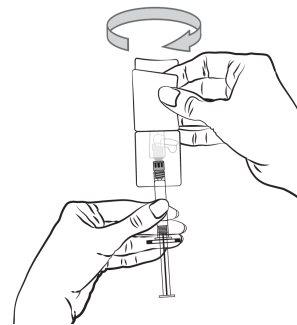
- Потягніть за захисний ковпачок, щоб відокремити його від голки по прямій лінії. Не обертайте захисний ковпачок, оскільки голка може від'єднатися від шприца.
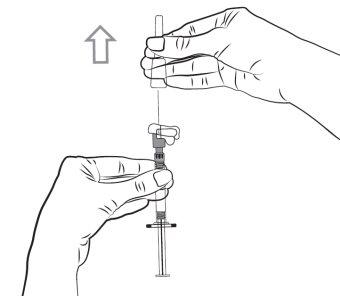
- Помістіть шприц з голкою в вертикальне положення для видалення повітря. Видаліть повітря з шприца, осторожно натискаючи на поршень вперед.
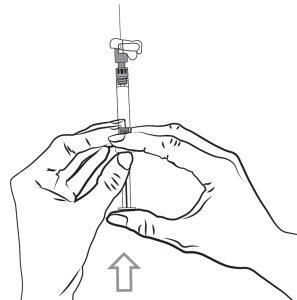
- Введіть весь вміст повільно, глибоко в м'яз дельтоподібний або глутеальний пацієнта. Не вводіть інтраваскулярно або підшкірно.
- Після закінчення ін'єкції використайте великий палець або інший палець руки (8а, 8б) або плоску поверхню (8в), щоб активувати систему захисту голки. Система повністю активується, коли чути клацання. Витратіть шприц з голкою належним чином.
8а
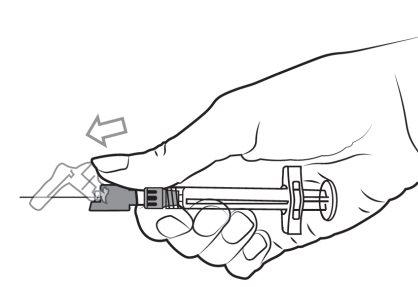
8б
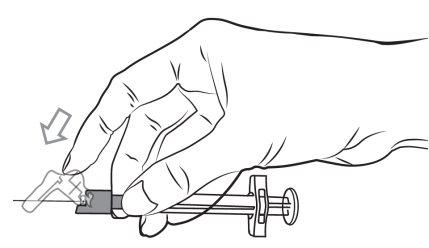
8в


Скільки коштує ПАЛЬМЕУКС 50 мг СУСПЕНЗІЯ ДЛЯ ІН'ЄКЦІЙ ПРОЛОНГОВАНОЇ ДІЇ У ПЕРЕДНАПОВНЕНИХ ШПРИЦАХ в Іспанії у 2025 році?
ПАЛЬМЕУКС 50 мг СУСПЕНЗІЯ ДЛЯ ІН'ЄКЦІЙ ПРОЛОНГОВАНОЇ ДІЇ У ПЕРЕДНАПОВНЕНИХ ШПРИЦАХ коштує в середньому 104.73 євро у жовтень, 2025 році. Ціна може змінюватися залежно від регіону, аптеки та наявності рецепта. Рекомендуємо перевіряти актуальну вартість у місцевих аптеках або через онлайн-сервіси.
- Країна реєстрації
- Середня ціна в аптеках104.73 EUR
- Діючі речовини
- Потрібен рецептТак
- Виробник
- СкладPOLISORBATO 20 (6 mg mg), HIDROGENOFOSFATO DE SODIO ANHIDRO (2,5 mg mg), DIHIDROGENOFOSFATO DE SODIO MONOHIDRATO (1,2 mg mg), HIDROXIDO DE SODIO (E 524) (7 pH mg)
- Інформація є довідковою і не є медичною порадою. Перед прийомом будь-яких препаратів обов'язково проконсультуйтеся з лікарем. Oladoctor не несе відповідальності за медичні рішення, прийняті на основі цього контенту.
- Альтернативи до ПАЛЬМЕУКС 50 мг СУСПЕНЗІЯ ДЛЯ ІН'ЄКЦІЙ ПРОЛОНГОВАНОЇ ДІЇ У ПЕРЕДНАПОВНЕНИХ ШПРИЦАХФорма випуску: РОЗЧИН ДЛЯ ІН'ЄКЦІЙ, 150 мг + 100 мгДіючі речовини: paliperidoneВиробник: Teva Pharma S.L.U.Потрібен рецептФорма випуску: РОЗЧИН ДЛЯ ІН'ЄКЦІЙ, 50 мгДіючі речовини: paliperidoneВиробник: Teva Pharma S.L.U.Потрібен рецептФорма випуску: РОЗЧИН ДЛЯ ІН'ЄКЦІЙ, 1000 мгДіючі речовини: paliperidoneВиробник: Janssen-Cilag International N.VПотрібен рецепт




